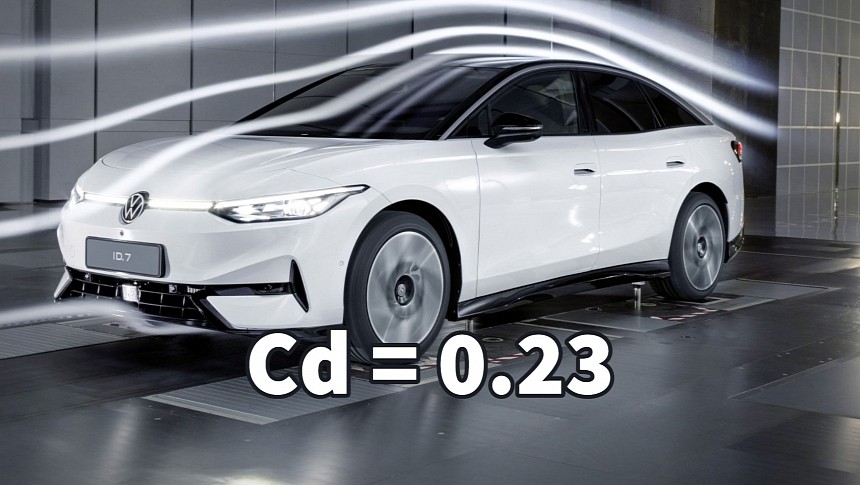When Volkswagen launched the ID.7 on April 17, it wowed everybody with a claimed range of 435 miles, or 700 km, according to the European cycle WLTP. Now, the German carmaker explained how it fine-tuned the ID.7's aerodynamics to achieve that impressive result.
Volkswagen launched the ID.7 during the Shanghai Auto Show, putting even more weight behind its China-first strategy. The mid-size electric sedan will start sales later this year in Europe and sometime next year in the US. Volkswagen communicated an impressive range, up to 700 km (435 miles), according to the European WLTP cycle. Based on my estimates, it should translate into about 320 miles (483 km) EPA range in the US.
This puts it below the Tesla Model S, which has an EPA range of 405 miles. The difference is caused by the difference in battery capacity (85 kWh for the ID.7 in Pro S trim versus 100 kWh for the Model S) and other factors. If Volkswagen made the ID.7 as efficient as the Model S, it would go as far as 350 miles (563 km) on a charge, based solely on the battery capacity difference. Still, we know this is not the case, and Tesla's coefficient of drag (Cd) of 0.21 is unmatched by the ID.7, which has a Cd of 0.23. There are other areas where Tesla leads in efficiency throughout the drive train and power electronics, so 320 miles is a realistic expectation.
Volkswagen is still proud of the ID.7's aerodynamics, fine-tuned in computer simulations and the wind tunnel. The German carmaker explained how it made the ID.7 as aerodynamically efficient as possible. The focus was on the body shape, which accounts for about 50 percent of the Cd value. It might be hard to believe, but wheels and tires are almost as important, accounting for 30 percent of the result. The underfloor and the functional openings through which air flows to the radiators at the front account for 10 percent each.
The Volkswagen ID.7 might not be the most beautiful car design, but its shape helps it become the most aerodynamic ID. model so far. The sedan has a low front end, a flowing transition into the bonnet, and a raked windscreen. The coupe-like roofline and the tapering rear end are also designed for ideal aerodynamic performance. The designers cooperated closely with the engineers from the Development department. Numerous computer simulations for flow calculation were validated by tests in a wind tunnel as part of this fine-tuning process.
The completely closed underbody and the newly developed wheel spoilers on the front wheels are the icing on the cake. The goal was to guide the air along the wheels and under the vehicle with minimum turbulence. The ID.7 also features air curtains at the sides of the front bumper and flared side sills to direct the air around the car with minimal loss. Finally, the wheel rims also contribute to the impressive aerodynamics.
This puts it below the Tesla Model S, which has an EPA range of 405 miles. The difference is caused by the difference in battery capacity (85 kWh for the ID.7 in Pro S trim versus 100 kWh for the Model S) and other factors. If Volkswagen made the ID.7 as efficient as the Model S, it would go as far as 350 miles (563 km) on a charge, based solely on the battery capacity difference. Still, we know this is not the case, and Tesla's coefficient of drag (Cd) of 0.21 is unmatched by the ID.7, which has a Cd of 0.23. There are other areas where Tesla leads in efficiency throughout the drive train and power electronics, so 320 miles is a realistic expectation.
Volkswagen is still proud of the ID.7's aerodynamics, fine-tuned in computer simulations and the wind tunnel. The German carmaker explained how it made the ID.7 as aerodynamically efficient as possible. The focus was on the body shape, which accounts for about 50 percent of the Cd value. It might be hard to believe, but wheels and tires are almost as important, accounting for 30 percent of the result. The underfloor and the functional openings through which air flows to the radiators at the front account for 10 percent each.
The Volkswagen ID.7 might not be the most beautiful car design, but its shape helps it become the most aerodynamic ID. model so far. The sedan has a low front end, a flowing transition into the bonnet, and a raked windscreen. The coupe-like roofline and the tapering rear end are also designed for ideal aerodynamic performance. The designers cooperated closely with the engineers from the Development department. Numerous computer simulations for flow calculation were validated by tests in a wind tunnel as part of this fine-tuning process.
The completely closed underbody and the newly developed wheel spoilers on the front wheels are the icing on the cake. The goal was to guide the air along the wheels and under the vehicle with minimum turbulence. The ID.7 also features air curtains at the sides of the front bumper and flared side sills to direct the air around the car with minimal loss. Finally, the wheel rims also contribute to the impressive aerodynamics.












